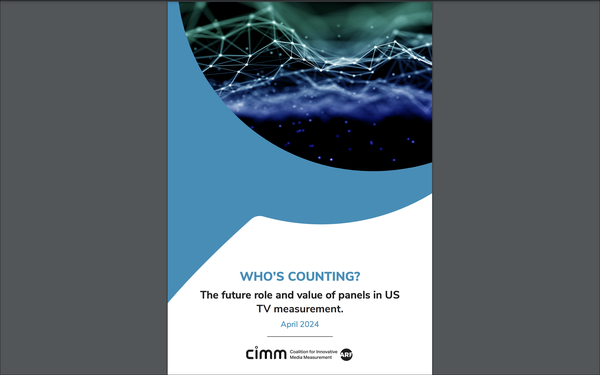
Thanks to CIMM (Coalition for
Innovative Media Measurement), a division of ARF (Advertising Research Foundation), the industry now has an incredibly comprehensive and detailed report on the value and projectable costs of
panel-based audience measurement.
Entitled
"Who’s Counting? The Future Role and Value of Panels in US TV Measurement," an alternative title would be "Everything You Needed to Know About Panels in TV Measurement but Were Afraid to
Ask!"
At 72 pages, this report is not light reading, even for the media research cognoscente.
Co-authored by Data ImpacX CEO Joan FitzGerald and Anonymous Media Research CEO Jonathan
Steuer, the report not unsurprisingly found that “Panels look set to remain a critical ingredient to measurement for the foreseeable future, enabling solutions for use cases that cannot be
addressed by big data alone.
advertisement
advertisement
“Although datasets from set-top boxes, smart TVs, and other
sources have tremendous utility for measurement, panels remain vital for calibrating, enriching, and commingling these datasets and enabling measurement of actual viewers rather than households.
Panels will continue to play a vital role in measuring viewing on unconnected TV platforms and of over-the-air channels.”
The elephant in the room is addressed via the report’s emphasis on the value of counting people rather than devices, as well as the importance
of eyes/ears-on measurement capability.
The paper also underlines the value of real
people-based panels for demographic adjustment and for cross-platform training as part of the device/surface measurement being used in the modeling approaches by Project HALO (World Federation of
Advertisers [WFA]), Project Origin (U.K.’s Incorporated Society of British Advertisers [ISBA]) and Aquila (U.S.’s Association of National Advertisers [ANA]).
These current industry projects are focused on “getting the counting right.” They are
based on measuring content rendered on devices/surfaces, because it is machinable, fast, and relatively low cost in a digital environment. They put aside the fundamental value of panels and
various techniques to measure people’s actual viewing needed to significantly enhance Big Data sources and/or “faux individuals” via virtual identities (VIDs).
In the TV/video cross-platform and cross-media measurement arenas, have we conveniently sidelined
The Attention Council’s mantra: “No attention, no outcomes?”
Have we also ignored the principle that using AI to enrich Big Data sets and VIDs are only as good as the training
models, i.e., exquisite representative people panels?
Measures of devices/surfaces –
a.k.a. “content rendered counts” -- or the Media Rating Council’s so-called “viewable impressions” -- have no empirical persons eyes/ears-on measurement.
Consequently, any inferences of generating an opportunity-to-see (OTS) from “content rendered counts,” even hypothetical OTS vs. what have been called “Real OTS” or
“viewing” measures, are moot.
While theoretical claims of
OTS can be made for smartphones and desktops based on device/surface measures, they cannot be made for the in-home, traditional multi-set, multiple persons TV environment due to the importance of
differentiating real viewers (Real OTS) per viewing household, nor for other non-digital media.
In this report, two use cases -- “personification” and “attention and engagement” -- emphasize using panels to get beyond “content
rendered” and to understand at a minimum OTS, and in the case of “attention,” to understand eyes/ears-on, as well. Another part specifically calls out OTS concerns.
If persons-based eyes/ears-on TV viewing is not measured -- whether via a panel or other empirical
means -- are solely device/surface-based content measures an acceptable planning or buying surrogate? Absolutely not.
This report makes it clear that both “personification” and eyes-on/attention are important and that inclusion of sophisticated panel-based measurement as part
of any integrated approach is likely the only way to address those use cases despite the costs.
So, will the WFA’s “Project HALO”, ISBA’s “Project Origin,” and the ANA’s “Project Aquila” take hold? Yes, because
they are essentially funded and managed by Google and Meta, to serve their interests vs. TV (linear and streaming) and other media.
The basic metric will be at the content-rendered-counts level
and therefore will report only anecdotal OTS, at best.
Will the industry fully
embrace this comprehensive CIMM TV measurement report on the value and dimensions of panels despite the potential cost of doing it right? Doubtful.
Will it embrace people panels measuring eyes/ears-on based TV/video viewing metrics in the ad-attention economy so media
agencies can buy what they plan and plan what they buy? The elephant holds the answer.